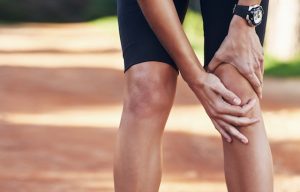
Do you have a hard time walking long distances because of knee pain? You used to love going for runs, but your knees are too painful to run anymore. Long walks with your spouse, dog, or golf buddies are no longer possible. Maybe your knees even ache randomly at rest? In this article, I will discuss five common causes of knee pain and what I do to treat them.
Knee pain affects about 25% of adults and limits a person’s mobility and quality of life. (1, 2, 3, 4) I struggled with numerous acute knee injuries as a teenager. I know how much of a bummer it is to be on the “disabled” list and not being able to enjoy my sports and physical activity.
Knee pain is a common complaint in my practice. A thorough history and examination will often reveal what’s causing the knee pain. However, sometimes providing a treatment helps determine what was causing the knee pain. In other words, the diagnosis is revealed through trial and error.
Knee joint misalignment
There are three knee joints that should be assessed for misalignments. To make this easier to understand, I look to see if the knee cap, shin bone (tibia), and the fibula (a long bone on the outside part of the shin bone) are in their proper position or not. If they aren’t, I pull or push the bone back into it’s proper position (adjustment). Sometimes, that’s all you need to do to get rid of knee pain.
Another common problem associated with knee joint misalignments are weak yet tight muscles around the knee joint. For example, if the knee cap is misaligned upwards, the only cause I have found is a tight thigh/quadricep muscle. Getting some type of soft tissue therapy to break up scar adhesions within the thigh muscle will loosen and strengthen it. This will allow the knee cap to fall back into it’s normal position.
Pinched nerve in the low back
Often times, if there is a bone out of alignment in your lower back, you can get knee pain associated with low back pain and thigh pain. The nerves from the low back travel from the spine into the leg. A bone that is out of alignment in the lower back can pinch a nerve or cause referred pain into the thigh leg, knee, and/or foot. Realigning the spine (adjustments) helps to restore proper nerve function and can take the pressure off of the pinched nerve. Knee pain often goes away.
I have had many cases of patients complaining of leg or knee pain without low back pain. When I adjust their low backs, their leg and knee pain went away. I remember a patient early on in my career that had left knee pain for 8 years. I examined his knee and took x-rays. I didn’t find anything wrong with his knee, but did find misalignments in his low back. After one adjustment to his lower back his left knee pain went away.
Flat feet
In a previous article, I talked about how flat feet creates a lot of stress on the knees, hips, and entire spine . The added stress on the muscles, ligaments and cartilage in and around the knee will eventually cause knee pain. Knowing what I know now, my flat feet had weakened my knee ligaments over time. As a result, my knee easily gave out if I put too much torque on it when playing sports.
If you have flat feet, I would highly recommend you get a pair of custom foot orthotics from a licensed health practitioner. The orthotics will help correct your flat feet and take the stress off of your knees.
I should point out, that sometimes a change of shoes is all that is needed to help your knee pain.
Inflammation
Persistent knee pain that won’t go away is a telltale sign of underlying inflammation (swellling). Inflammation comes from a variety of sources and should be investigated thoroughly. Here is a list of common causes:
-
- Food intolerances
- Underlying gut problems
- Mental stress
- Osteoarthritis
When you find out what’s causing your inflammation, treatment is focussed, and is more apt to get rid of your inflammation and knee pain.
Being Overweight or Obese
Being overweight or obese puts extra weight and stress on on your feet, knees, hips, and low back. The extra stress on the those joints wears them out faster increasing your likelihood of developing chronic pain. In fact, obesity is a strong risk factor for knee pain and increases the risk of symptomatic knee osteoarthritis (5, 6).
Furthermore, being overweight or obese also causes all of the above reasons that knee pain occurs: knee joint misalignment, pinched nerve in the lower back, flat feet, and inflammation. It’s a vicious cycle.
Losing weight isn’t easy for everybody. There are hidden cases to weight loss resistance you wouldn’t even think about.
Summary
I have given you five common causes of knee pain. If you figure out the underlying cause(s) and treat that, you will be more likely to rid yourself of knee pain. You can then return to the activities you once enjoyed.


I must say this is really very impressive guide on knee pain. Thanks for sharing this info in such a detailed way.
Thank you Jon.
Dr. Collins